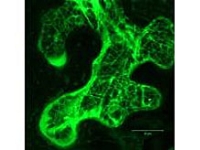 Membrane lipids and cytoskeleton dynamics are intimately interconnected in the eukaryotic cell, but only recently have the molecular mechanisms operating at this interface in plant cells been addressed experimentally.
Membrane lipids and cytoskeleton dynamics are intimately interconnected in the eukaryotic cell, but only recently have the molecular mechanisms operating at this interface in plant cells been addressed experimentally.
F-actin microfilaments and microtubules are major constituents of the cellular cytoskeleton in
plant cells as well. Nevertheless, plant cells are strained by developmental as well as
environmental mechanical challenges because of the crucial structural and regulatory function of
the cell wall.
This is why signaling and the mechanics of the membrane lipids-cytoskeleton interface is
rather dissimilar and specific in plant cells. Recently, researchers from the Institute of
Experimental Botany, ASCR, and the Faculty of Science, Charles University, in collaboration with
colleagues from the Institute of Chemical Technology in Prague have discovered that the membrane
modifying enzyme phospholipase D (PLD) is the active partner in the membrane-actin interplay. They
have described the positive feedback loop created by the activation of PLD by F-actin and the
activation of F-actin by a product of PLD activity – phosphatidic acid.
This regulatory link provides an important mechanism to increase the membrane-F-actin
dynamics in the cortex of plant cells locally. The same two laboratories from the ASCR and Charles
University collaborated with colleagues from Durham University, UK on the discovery of a new type
of F-actin nucleator (formin) capable of combining actin nucleation with anchoring in the lipid
membrane and direct links to the microtubular cytoskeleton. Both of these reports provide new
insight into the understanding of how plant cells regulate the cytoskeleton-membrane interface to
combine high mechanical stress-resistance with the necessity of dynamics and plasticity.
21 May 2010



